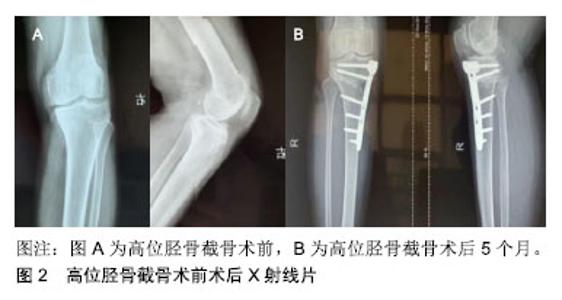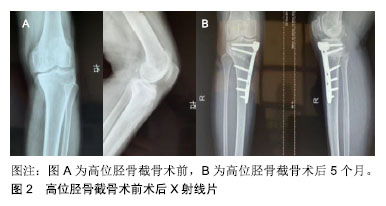Chinese Journal of Tissue Engineering Research ›› 2019, Vol. 23 ›› Issue (32): 5216-5220.doi: 10.3969/j.issn.2095-4344.1342
Previous Articles Next Articles
Individualized treatment of knee osteoarthritis
Meng Wei
- Binhai Hospital, General Hospital of Tianjin Medical University, Tianjin 300480, China
-
Online:2019-11-18Published:2019-11-18 -
About author:Meng Wei, Associate chief physician, Binhai Hospital, General Hospital of Tianjin Medical University, Tianjin 300480, China
CLC Number:
Cite this article
Meng Wei. Individualized treatment of knee osteoarthritis[J]. Chinese Journal of Tissue Engineering Research, 2019, 23(32): 5216-5220.
share this article

2.1 膝骨关节炎病因及诊断 膝关节骨关节炎分为原发性和继发性,原发性的病因尚不明确[5],其常见原因有:①女性在闭经后高发;②肥胖;③年龄因素;④摄入及吸收障碍;⑤地区因素;⑥骨质疏松。钟培瑞等[6]通过研究骨质疏松症与大鼠膝骨关节炎发病的关系,得出结论:骨质疏松症在一定程度上能促进骨关节炎的发展。 膝关节骨关节炎的临床表现一般会出现病程较长的关节肿痛及僵硬。通常膝关节骨关节炎的影像学表现为:膝关节X射线及CT显示膝关节骨赘形成,关节间隙减小甚至消失。MRI表现为软骨下骨质内片状高信号影,软骨表面粗糙,软骨缺失,呈现锯齿样改变,骨髓水肿[7]。 2.2 治疗方法 现阶段对于膝关节骨关节炎的诊治方案很多,包括保守治疗及手术治疗等。保守治疗主要是理疗、健康宣教、运动治疗、口服药物治疗以及自体富含血小板血浆注射等疗法。 2.2.1 保守治疗 对于症状轻微患者,一般可以选择物理治疗,能够起到镇痛、增加关节屈伸角度的作用。非药物治疗方法包括健康宣教、减轻自身体质量、康复器械、功能锻炼等。康复锻炼对关节周围的肌肉耐力和肌肉力量的提高很有帮助,关节更加稳定,预防肌肉废用性萎缩,预防关节活动受限,进而能够迟滞骨质疏松的进程[8]。 2.2.2 药物治疗 (1)缓解症状药物:常见的如布洛芬、阿司匹林、吲哚美辛等,通过与环氧合酶结合减少前列腺素的生成,从而减少炎症因子的出现。通过以上因素,减轻了膝关节骨关节炎患者炎症反应和疼痛程度,但其副反应是对中枢神经系统、胃肠道、肾脏的不良反应,进一步加重关节损伤。目前临床比较常用的药物如塞来昔布、氟比洛芬等非类固醇抗炎药通过选择性抑制环氧合酶2,明显减低了其不良反应。李明辉等[9]针对盐酸氨基葡萄糖联合塞来昔布治疗膝骨关节炎的随机对照研究中得出结论:对于中度膝骨关节炎,使用盐酸氨基葡萄糖建议联合塞来昔布等非类固醇类抗炎药类用药,可以较好改善临床症状。选择非类固醇抗炎药其副反应有增加心血管疾病风险。氟比洛芬巴布膏是最常用的体表用非类固醇抗炎药,可避免口服并发症,皮肤过敏发生率很低,镇痛效果显著。 (2)缓解关节炎进程的药物:主要有双膦酸盐、硫酸氨基葡萄糖等。双膦酸盐作为一种较强的骨吸收抑制剂,具有与焦磷酸盐相似的结构,易沉积在骨组织内,与钙盐结合力强,因此可提高骨组织的抗吸收能力,尤其是破骨细胞的再吸收能力。硫酸氨基葡萄糖可抑制磷脂酶A及胶原酶活性,抑制软骨基质的降解,促进关节液生成,帮助软骨自体修复、帮助关节正常功能的发挥[10]。2016年Hochberg等[11]的双盲试验通过硫酸软骨素和硫酸葡萄糖胺联合应用与单独使用塞来昔布疗效的对比发现,硫酸葡萄糖胺和硫酸软骨素联合应用对膝关节骨关节炎患者改善关节功能及减轻有明显的改善,其效果与塞来昔布一样。 2.2.3 附加治疗 如果使用药物治疗效果不明显,可以采用以下治疗方案。 Yang等[12]研究发现关节囊、滑膜和软骨下骨是骨关节炎引起疼痛的刺激感受器的神经末梢所在区,软骨区没有发现。透明质酸钠可以延缓软骨细胞死亡,其在关节腔内注射可缓解疼痛,恢复基质的黏弹性并有润滑作用,可保护覆盖关节软骨面。 间充质干细胞制作简单,材料多,应用前景广泛。具有多向分化能力、可塑性强、免疫原性低、可旁分泌多种生物活性因子和致畸致瘤风险低等优良生物学特点,并已逐渐用于局灶性缺陷和广泛性骨关节炎的临床治疗,在骨关节炎和软骨缺损的治疗中具有重要意义[13-14]。宋卓悦 等[15]研究结果表明,联合应用脂肪来源间充质干细胞及滑膜来源间充质干细胞对炎性软骨细胞退变具有协同抑制作用。有研究发现骨髓间充质干细胞作为种子细胞可分化为成软骨细胞和成骨细胞,Runx2基因位于人类常染色体的6p21,能够诱导骨髓间充质干细胞向成软骨细胞和成骨细分化、成熟,从而促进骨愈合。有学者在此基础上做了相关研究,其结果说明,Runx2慢病毒转染骨髓间充质干细胞能够促进骨关节炎关节损伤修复,从而为骨关节炎的临床治疗提供新的方向。 血小板在自体富血小板血浆中大量存在,通常浓度在正常血小板浓度的5倍以上。从20世纪80年代开始富血小板血浆开始应用于临床治疗,20世纪90年代富血小板血浆的制作工艺得到了极大的改进,如通过血小板可以衍生生长因子、类胰岛等[16]。Chen等[17]的病例报告中采用膝关节内注射富血小板血浆,在后续随访过程中采用X射线摄影方式来判断效果,结果发现关节软骨确实重建,关节炎的状况也显著改善,在玻璃酸钠、封闭等传统治疗手段无效的情况下仍可以发挥效果,现阶段,此种治疗方案成为临床治疗膝关节骨关节炎的热点,有相关人员已经投身其临床实践中。但是目前富血小板血浆在骨关节炎的治疗中其临床作用仍存有争议。 2.2.4 手术治疗 主要包括关节镜下探查清理术和膝骨关节炎的阶梯治疗。 (1)关节镜下探查清理术:其适应证是保守治疗效果不满意,未到终末期的骨关节炎,如骨赘较多且影响膝关节活动。其优势是单个切口仅1 cm、疼痛症状较轻,术后膝关节肿胀不明显等微创治疗理念。如果适应证掌握不严,术后可能出现疗效不满意。骨赘在关节腔内,甚至会形成异物,阻碍其活动,容易导致关节绞锁,软骨层首先受累,随病程进展,软骨丢失,骨质外露于关节内。关节镜下探查清理术能够清楚骨赘及关节内的游离体,延缓关节软骨层的丢失,进而起到保护关节的作用。白云飞等[18]探讨关节镜下病灶清理治疗老年膝关节退行性骨关节炎的有效性及安全性,结果显示采用关节镜下病灶清理治疗老年膝关节退行性骨关节炎,具有创伤小,减轻患者疼痛,降低不良反应发生率,节省住院费用,可促进膝关节功能等优势。 (2)膝骨关节炎的阶梯治疗:膝关节周围截骨术:随着膝关节置换术的兴起,国内外截骨矫形术的数量逐渐减少,但近年来胫骨高位截骨术又引起了国内外专家的关注,作为保膝治疗的重要手段,成为新的焦点。1961年 Jackson和Waugh报道了胫骨结节下截骨术;1962年 Wardle报道了胫骨结节下1.0-2.0 cm截骨,取得良好效果;1963年Conventry提出胫骨结节以上水平截骨,即高位胫骨截骨,临床效果良好。但是高位胫骨截骨的适应证很窄,目前共识的高位胫骨截骨最佳适应证如下:患者年龄一般在65岁以下;关节屈伸范围基本正常;无明显屈曲挛缩;胫骨近端内侧角小于85°;膝关节外侧间室基本正常。王兴山等[19]认为胫骨近端外侧骨皮质连续性完整,内侧向上的撑开面骨质有接触,内侧纵行撑开距离小于2 cm,植骨为非必要。目前采取最多的,也是临床术后效果最好的是胫骨高位截骨术,随着新型解剖型锁定接骨板以及定制型接骨板的不断改进,新型截骨导板的应用,加上同种异体骨植骨,其临床疗效显著,见图2,成为保膝治疗重要环节,在此基础上,“保膝”理念成为热点及焦点。"


单髁置换术:单髁置换技术始于20世纪60年代,但早期的治疗结果并不如人意。在随后的30多年里,假体的设计不断被改进,有效改善了单髁置换的治疗结果。有国外研究显示,此病发生逐渐年轻化,而在所有的膝关节炎病例中,1/3左右发病区域仅涉及膝关节单间室,其他2个间室膝骨关节炎进程较慢,一般内侧间室膝骨关节炎最严重,也最常见[20]。林汉文等[21]通过研究骨关节炎患者下肢力线改变与疼痛部位的关系,结果说明膝骨关节炎伴膝关节疼痛患者多存在高位髌骨,股胫关节半脱位程度加重,股胫内外侧关节间隙变窄,其中膝前区疼痛患者的股胫关节半脱位程度较膝内侧更加严重。单髁置换的优势在于仅仅置换病变间室,保留本体感觉及软组织功能。具有切口小(仅有8-10 cm)、创伤小,出血少、术后无明显疼痛、康复迅速等优点,患者术后可以当天下地,活动度很轻松达到90°,1周左右即可生活自理,用起来和自己原来的关节差不多。盛夏等[22]在单髁置换治疗膝关节前内侧单间室骨关节炎方面,如果能准确的把握手术适应证,选择合适的患者,精心的术前准备、熟练的手术操作临床效果还是令人满意的。近几年,单髁置换技术不断完善,假体设计更新更加合理,其假体生存率越来越高,患者满意度越来越高,单髁置换成为保膝治疗重要一环。目前应用最为广泛的是2种单髁置换假体:解剖型固定平台假体和活动平台假体。前者以捷迈邦美ZUK单髁膝关节假体、LINK®Sled单髁膝关节假体为代表,后者以捷迈邦美Oxford®牛津单髁膝关节系统为代表。有学者研究了105例采用解剖型固定平台单髁置换治疗伴有前侧间室(髌股关节)轻中度膝骨关节炎,显示前侧间室膝骨关节炎对术后膝关节的功能无明显影响,因此即使患者出现了前侧间室(髌股关节)轻中度膝骨关节炎,也可以采用单髁置换治疗。 人工全膝关节置换:人工全膝关节置换作为晚期膝关节病变的最终治疗方法已经为广泛接受,可以有效减轻疼痛、缓解症状、矫正畸形,提高患者的生活质量。成功的全膝关节置换术后可以使患者无痛地生活并满足日常活动,对于终末期膝关节骨关节炎,其他治疗方法均不能达到同等疗效。国内全膝关节置换手术量也增长迅猛。陈焕诗等[23]对24例膝关节骨关节炎患者进行人工膝关节表面置换术,取得满意疗效,优良率达90%。但其术后并发症的出现给患者及医生带来很多烦恼,有些还是灾难性的,如术后感染、关节脱位、假体松动、假体周围骨折等问题,有些还需进行二次手术治疗。目前临床的手术疗效良好,但未来磨耗、偏位或感染可能需要进行第二次手术,常由于骨质移除量较多,因此手术效果要比初次手术还不理想。国外学者针对15 321例患者进行追踪随访,56%的患者在全膝关节置换术后4周内出现了不同的并发症,死亡率达0.18%[24]。"

| [1]Huétink K, Stoel BC, Watt I, et al. Identification of factors associated with the development of knee osteoarthritis in a young to middle-aged cohort of patients with knee complaints. Clin Rheumatol. 2015; 34(10): 1769-1779.[2]周文娟,吴云翔,易军.糖化血红蛋白标准化及其检测技术的发展[J].生物化学与生物物理进展,2015,42(5):443-456.[3]Heidari B. Knee osteoarthritis prevalence, risk factors, pathogenesis and features: part I. Caspian J Int Med. 2011; 2(2):205-212.[4]Kohn MD,Sassoon AA,Fernando ND. Classificationsin Brief:Kellgre-Lawrence Classification of Osteoarthritis. Clin Orthop Relat Res. 2016;474(8):1886-1893.[5]昌睿杰,赵颖,罗卉丽.糖化血红蛋白在糖尿病筛查中的应用及意义[J].中国医药导报,2015,12(1):86-89.[6]钟培瑞,廖瑛,廖源,等.去卵巢对大鼠膝关节软骨及软骨下骨的影响[J].风湿病与关节炎,2017,6(11):5-10.[7]Freitag J,Bates D,Boyd R,et al. Mesenchymal stem cell therapy in the treatment of osteoarthritis : reparative pathways, safety and efficacy-a review. BMC Musculoskelet Disord. 2016;17:230.[8]罗灏,刘君.康复训练在早期膝骨关节炎患者中应用价值的对比研究[J].安徽医药,2014,18(6):1077-1079.[9]李明辉,刘洋,王彩民,等.盐酸氨基葡萄糖联合塞来昔布治疗膝骨性关节炎的随机对照[J].中国组织工程研究,2013,17(43): 7654-7660.[10]Pecchi E, Priam S, Mladenovic Z, et al. A potential role of chondroitin sulfate on bone in osteoarthritis: inhibition of prostaglandin E? and matrix metalloproteinases synthesis in interleukin-1β-stimulated osteoblasts. Osteoarthritis Cartilage. 2012;20(2):127-135.[11]Hochberg MC, Martel-pelletier J, Monfort J, et al. Combined chondroitin sulfate and glucosamine for painful knee osteoarthritis : a multicentre, randomised, double-blind, non-inferiority trial versus celecoxib. Ann Rheum Dis. 2016; 75(1):37-44.[12]Yang L, Zhang J, Wang G. The effect of sodium hyaluronate treating knee osteoarthritis on synovial fluid interleukin-1β and clinical treatment mechanism. Pak J Pharm Sci. 2015; 28(1 Suppl): 407-410.[13]Pers YM, Ruiz M, Noel D, et al. Mesenchymal stem cells for the management of inflammation in osteoarthritis: state of the art and perspectives. Osteoarthritis Cartilage. 2015;23(11) : 2027-2035.[14]张钟元,江和训,赵锦伟,等.关节镜清理联合自体骨髓间充质干细胞移植治疗膝骨关节炎疗效观察[J].风湿病与关节炎, 2018,7(6): 39-42.[15]宋卓悦,王洋,连晓磊,等.人脂肪间充质干细胞和滑膜间充质干细胞协同抑制炎性软骨细胞的退变[J].中国组织工程研究, 2018, 22(17):2661-2668.[16]翟利锋,马苟平,黄凯,等.富血小板血浆关节腔注射联合穴位注射治疗膝骨性关节炎临床研究[J]. 浙江中西医结合杂志, 2018, 28(10): 871-874.[17]Chen SH, Kuan TS, Kao MJ, et al. Clinical effectiveness in severe knee osteoarthritis after intra-articular platelet-rich plasma therapy in association with hyaluronic acid injection: three case reports. Clin Interv Aging. 2016;11: 12131219.[18]白云飞,房体刚,孙瑞.关节镜下有限清理术后配合下肢肌肉链训练治疗老年膝骨关节炎的疗效[J].中国老年学杂志,2018,38(8): 1898-1900.[19]王兴山,柳剑,顾建明,等. 改良闭合楔形胫骨高位截骨术治疗膝内翻畸形的疗效观察[J].中华关节外科杂志(电子版), 2016, 10(5):474-480.[20]Dunn AS, Petterson SC, Plancher KD. Unicondylar knee arthroplasty: intramedullary technique. Clin Sports Med. 2014;33(1):87-104.[21]林汉文,温俊茂,黄超原,等.骨性关节炎患者下肢力线改变与疼痛部位的关系:影像学评价[J].中国组织工程研究,2017,21(7): 1110-1114.[22]盛夏,包洪卫.膝关节单髁置换术治疗膝内侧单间室骨关节炎体会[J].心理医生,2016,22(29): 140-141.[23]陈焕诗,金伟,许峰.人工全膝关节置换术治疗膝关节骨关节炎[J].实用骨科杂志,2009,9(7):193-195.[24]Belmont PJ Jr, Goodman GP, Waterman BR, et al. Thiaydaypostoperativecomplicationsand mortalityfollowingtotal knee arthro-plasty:incidenceand risk factors among a national sample of 15321 patients. J Bone Joint Surg Am. 2014;96(1):20-26. |
| [1] | Jiao Hui, Zhang Yining, Song Yuqing, Lin Yu, Wang Xiuli. Advances in research and application of breast cancer organoids [J]. Chinese Journal of Tissue Engineering Research, 2021, 25(7): 1122-1128. |
| [2] | Cao Xuhan, Bai Zixing, Sun Chengyi, Yang Yanjun, Sun Weidong. Mechanism of “Ruxiang-Moyao” herbal pair in the treatment of knee osteoarthritis based on network pharmacology [J]. Chinese Journal of Tissue Engineering Research, 2021, 25(5): 746-753. |
| [3] | Li Yonghua, Feng Qiang, Tan Renting, Huang Shifu, Qiu Jinlong, Yin Heng. Molecular mechanism of Eucommia ulmoides active ingredients treating synovitis of knee osteoarthritis: an analysis based on network pharmacology [J]. Chinese Journal of Tissue Engineering Research, 2021, 25(5): 765-771. |
| [4] | Jie Ke, Deng Peng, Zeng Yirong. Application and comparison of four commonly used methods for patellar height measurement [J]. Chinese Journal of Tissue Engineering Research, 2021, 25(24): 3875-3881. |
| [5] | Yang Wei, Chen Zehua, Yi Zhiyong, Huang Xudong, Han Qingmin, Zhang Ronghua. Effectiveness of intra-articular injection of hyaluronic acid versus placebo in the treatment of early and mid-stage knee osteoarthritis: a Meta-analysis based on randomized, double-blind, controlled, clinical trials [J]. Chinese Journal of Tissue Engineering Research, 2021, 25(23): 3760-3766. |
| [6] | Zuo Xiuqin, Yin Sasa, Xie Huimin, Jia Zishan, Zhang Lining. Applicability and specifications of platelet-rich plasma in musculoskeletal repair [J]. Chinese Journal of Tissue Engineering Research, 2021, 25(20): 3239-3245. |
| [7] | Zhu Shiqiang, Xu Jianfeng, Hei Xiaoyan, Chen Yundong, Tian Xinbao, Zhang Jinchen, Lin Ruizhu. Effect of internal heat-type acupuncture needle therapy on the expression of type I collagen, matrix metalloproteinase-3 and osteopontin in the subchondral bone of rabbit knee osteoarthritis model [J]. Chinese Journal of Tissue Engineering Research, 2021, 25(17): 2636-2642. |
| [8] | Yin Yuhui, Zhan Jiawen, Wang Shangquan, Shao Chenchen, Zhou Liang. Meta-analysis of acupuncture combined with massage in the treatment of knee osteoarthritis [J]. Chinese Journal of Tissue Engineering Research, 2021, 25(17): 2719-2726. |
| [9] | Ma Zhen, Liang Da, Wu Xiaolin, Zhong Wei . Safety evaluation of tranexamic acid in reducing perioperative blood loss in high tibial osteotomy [J]. Chinese Journal of Tissue Engineering Research, 2021, 25(12): 1847-1852. |
| [10] | Zhou Qi, Gao Yi, Wei Kang, Li Jun, Xu Jianda, Jiang Yang, Qu Yuxing. Total knee arthroplasty for rheumatoid arthritis: knee function and biochemical index changes [J]. Chinese Journal of Tissue Engineering Research, 2020, 24(9): 1337-1341. |
| [11] | Liu Yu, Zhang Nanxin, Dai Liqun, Ying Wei. Meta-analysis of the effectiveness of cold therapy after total knee arthroplasty [J]. Chinese Journal of Tissue Engineering Research, 2020, 24(9): 1443-1448. |
| [12] | Xu Qi, Zhang Chao, Ha Chengzhi, Wang Dawei. Susceptibility genes related to non-traumatic femoral head necrosis: improving detection accuracy and developing new treatment strategy [J]. Chinese Journal of Tissue Engineering Research, 2020, 24(5): 747-752. |
| [13] | Jing Xiaowei, Mu Yingxiu. A study on anterior cruciate ligament injury and knee stability with a silicon mesh brace [J]. Chinese Journal of Tissue Engineering Research, 2020, 24(4): 505-510. |
| [14] | Deng Zengfa, He Zhiyong, Liu Kang, Yu Xinping, Liang Jianji, Wang Jinjun, Li Chen, Guo Zhouyang. Hemostatic effect and safety of intravenous combined with topical administration of tranexamic acid on unicompartmental knee arthroplasty [J]. Chinese Journal of Tissue Engineering Research, 2020, 24(36): 5793-5799. |
| [15] | Huo Shaochuan, Wang Haibin, Tang Hongyu, Wang Yueqi, Chen Qunqun, Feng Ziyu, Li Yikai. Treatment of knee osteoarthritis by tonifying kidney and spleen and activating blood circulation herbs via chondrocyte IL-1beta/ERR-alpha/SOX9/Col2alpha1 signaling pathway in a rat model [J]. Chinese Journal of Tissue Engineering Research, 2020, 24(35): 5577-5581. |
| Viewed | ||||||
|
Full text |
|
|||||
|
Abstract |
|
|||||